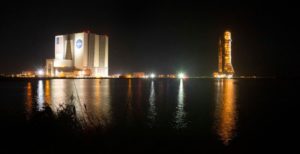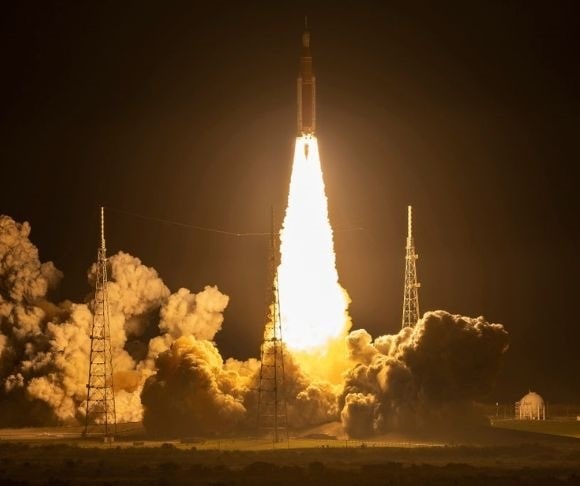After weeks of anticipation and two scrubbed launches, NASA’s new Artemis 1 Space Launch System (SLS) rose into the air from the Kennedy Space Center’s Pad 39B at 1:47 a.m. EST on November 16. Those early risers who witnessed the first in the series of Artemis missions to the Moon were rewarded. They heard the air-shattering, crackling sounds of two million pounds of thrust from four RS-25 rocket engines combined with two 17-story-tall solid rocket boosters strapped to the sides generating 3.6 million pounds of thrust each sending the three-stage, deep-space capable moon rocket soaring. “We rise together back to the moon and beyond,” the NASA narrator for the play-by-play said.
 The powerful sounds were magnified by the characteristic visual of roiling, billowing clouds of rocket engine exhaust and vapor from water sprayed at 1.1 million gallons per minute shooting from the Launch Pad 39B’s 450-foot-long flame trench. The trench experienced a scorching 2,200 degrees Fahrenheit during the launch. “What an incredible sight to see NASA’s Space Launch System rocket and Orion spacecraft launch together for the first time. This uncrewed flight test will push Orion to the limits in the rigors of deep space, helping us prepare for human exploration on the Moon and, ultimately, Mars,” NASA Administrator Bill Nelson said at a post-launch news conference.
The powerful sounds were magnified by the characteristic visual of roiling, billowing clouds of rocket engine exhaust and vapor from water sprayed at 1.1 million gallons per minute shooting from the Launch Pad 39B’s 450-foot-long flame trench. The trench experienced a scorching 2,200 degrees Fahrenheit during the launch. “What an incredible sight to see NASA’s Space Launch System rocket and Orion spacecraft launch together for the first time. This uncrewed flight test will push Orion to the limits in the rigors of deep space, helping us prepare for human exploration on the Moon and, ultimately, Mars,” NASA Administrator Bill Nelson said at a post-launch news conference.
The giant SLS rocket with the Orion spacecraft gracing the top is taller than a football field is long at 322 feet. The most powerful rocket ever developed, delivering a staggering 9.9 million pounds of thrust at liftoff, moved slowly skyward, gaining velocity with each passing second. Within minutes the spacecraft was approaching a speed to enter an interim orbit around Earth. At an hour and a half into the flight, the Artemis 1’s upper interim cryogenic propulsion stage (ICPS) engine fired for approximately 18 minutes, giving Orion the needed velocity, about 22,600 miles per hour, to escape Earth’s gravity and be on its way to the Moon. The maneuver is critical to the mission to achieve what is known as a trans-lunar injection (TLI). According to NASA, TLI enables Orion to make the 280,000-mile trip beyond Earth, and 40,000 miles passed the Moon. This distance is farther than any spacecraft certified and capable of carrying a manned crew has ever ventured.
Following the TLI boost, the ICPS separated from Orion with its solar arrays deployed for electrical power on its three-week mission to the Moon. The ICPS continued on a course similar to Orion’s after separation but includes the task of deploying ten small four cubic inch satellites. Liberty Nation explained in an earlier report on the Artemis 1 space mission, “The satellites — called Cubesats — will take up their discrete tracks to the moon to perform various experiments and demonstrations.” The Cubesats may remain to make more in-depth studies of the Moon or be diverted to gather data for future NASA deep space exploration. The fate of the ICPS will be to continue in a solar orbit, eventually being pulled by gravity into the Sun.

(Photo by Kevin Dietsch/Getty Images)
One of the reasons for the initial positioning of Orion 40,000 miles beyond the Moon to take up what NASA calls a distant retrograde orbit is to test NASA’s Deep Space Network (DSN) communications system. It fulfills the same function as GPS used here on Earth. The DSN is designed to guarantee satellites sent into deep space can reliably communicate with NASA ground stations.
Orion will return in approximately 25 days but could be in space for as long as 42 days. Upon entering the Earth’s atmosphere, it will undergo one of the spacecraft’s most critical tests. How will the capsule’s heat shield withstand temperatures approaching 5,000 degrees Fahrenheit without burning up in the atmosphere? If there is a successful reentry, Orion will be picked up in the Pacific Ocean near the coast of California.
The United States returning to the Moon after a half-century will be an accomplishment long overdue. Artemis 1 is the first of three man-capable lunar missions, with the third trip carrying a crew. After having to scrub two launches previously, having Orion on its way is a technological achievement of which the US can be proud. Putting a crew on the face of the moon will be just the first step to “and beyond.”
The views expressed are those of the author and not of any other affiliation.




